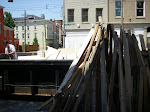



Reid and I re-entered the back building of the property this past weekend to take pictures & begin clearing out the space. The back building is 4 stories tall but, at only 500-600 square feet per floor, is manageable in size. However, it is packed with furniture, mattresses, clothes, toys, appliances, and half-destroyed bathroom fixtures. A copy of Time magazine, dated from 2003, was sitting on a table on the second floor. It is probably safe to assume that noone has lived there (as a rent-paying tenant) since that time.
The building has water damage, some of the ceilings have fallen in from it, and some floorboards have popped up. There were even mushrooms growing on top of a mattress on the floor!
When Reid and I had first entered this space a couple of months ago (we had never entered the space prior to purchasing the property), we found it to be a rather depressing window into how those with mental illness live. With depakote (a medicine used for bipolar disorder) samples lying in an open, empty suitcase on the floor and a used syringe in the windowsill of the only window that wasn't boarded up, envisioning the space as something we could actually one day live in seemed impossible.
Entering the space this past weekend wasn't as overwhelming.















